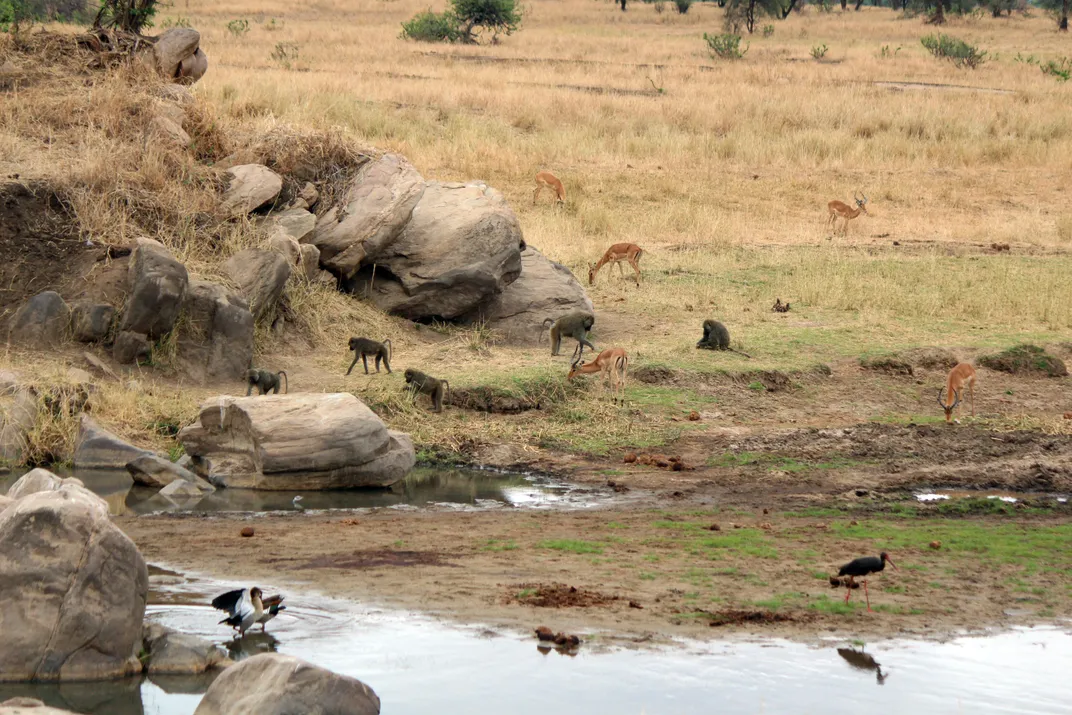Impalas Hang Out With Baboons for Sausage Fruits and Safety
Forget Timon and Pumbaa: In the African savannah, the best friends around may be impalas and baboons
/https://tf-cmsv2-smithsonianmag-media.s3.amazonaws.com/filer/06/42/06424065-1a8f-4178-a5c2-b0f517d87632/img_9769_2.jpg)
The impalas follow the baboons under the sausage tree, slurping up succulent snacks left behind by the primates. The normally skittish impalas relax as they feast in the shade, secure in the knowledge that the baboons are helping to keep a lookout for lurking predators.
Yes, truth really is stranger than a Disney movie.
If you happen to be traveling through the woodlands of Tarangire National Park in Tanzania, you may come upon impalas and baboons hanging out together. According to a new report, the ungulates have learned to shadow the baboons to find a quick bite and to take advantage of the extra sets of eyes looking for predators in the savannah.
The study is the first to provide solid data for an association between impalas and baboons that was originally noted more than 50 years ago, when researchers saw impalas eating seedpods and fruits dropped by olive baboons. At the time, the relationship was thought to be just a casual affair.
“When I started my research in Tanzania, I not only noticed that impala and baboons were spending a lot of time together, but the impala were also actively following the baboons. But at first I didn't know why,” says study co-author Brooke R. Davis, a student at Colorado College.
Baboon troops frequently dine on the flowers and fruits of the sausage tree, so named because the elongated fruits have rough grey rinds that give them a distinct appearance. After observing the animals for about two months in 2014, Davis realized that whenever the baboons were foraging from sausage trees, the impalas were there too.
“The impala can’t reach the sausage fruits, and even if the fruits fall, the impala can’t chew through the tough skin of the fruit, therefore the only way for them to access those nutrients is to take the scraps from the baboons,” says Davis.
But their association is not just about food, she adds—impalas were also found with baboons even when no sausage trees were in sight. Based on their behavior, it seems as if the impalas feel safer when the baboons are around.
“When impalas were with baboons, they spent about half as much time with their heads up looking around as they did when baboons were not present,” she says.
In 2010, anthropologist Dawn Kitchen of Ohio State University found that impalas, along with tsessebe, wildebeest and zebra, were able to distinguish chacma baboons’ alarm calls from the very similar contest calls the monkeys make to communicate with each other. Impalas seem to excel at this behavior, and it may have to do with their unique ties to the primates, says Kitchen.
“It might be possible that impala are associating with baboons originally due to this otherwise unavailable foraging opportunity. Then, because they are associating so frequently, they are in a better position to learn to distinguish the two call types than are the other ungulates who rarely mingle with the baboons,” says Kitchen.
The findings highlight the importance of looking at subtle relationships in the animal kingdom, says James J. Ebersole, a professor at Colorado College and co-author of the study, published November 21 in the African Journal of Ecology.
“We know a fair bit about how predators affect prey and how directly-competing species influence each other, but we do not know enough about more subtle interactions such as this one," he says. "We hope that our study contributes to raising awareness of the importance of looking for and studying these types of relationships,” he adds.

In particular, the findings provide important insights about the possible benefits of different species interacting with each other to avoid common predators, says Yamato Tsuji, a mammal ecologist at the Primate Research Institute in Kyoto University, Japan. Very few studies have provided convincing evidence for such an association, and Tsuji points out that scientists will need more time to verify any theories related to the Tanzanian duo.
“Unfortunately the observation period is too short, and whether these effects occur every season/year is unknown," he says. "I hope the authors continue collecting the data on the project.”
That's exactly what Davis hopes to do in future: “If I have the opportunity to continue this research I would love to see how this relationship changes throughout the seasons, and I would like to explore the possible benefits of this relationship to the baboons,” she says.